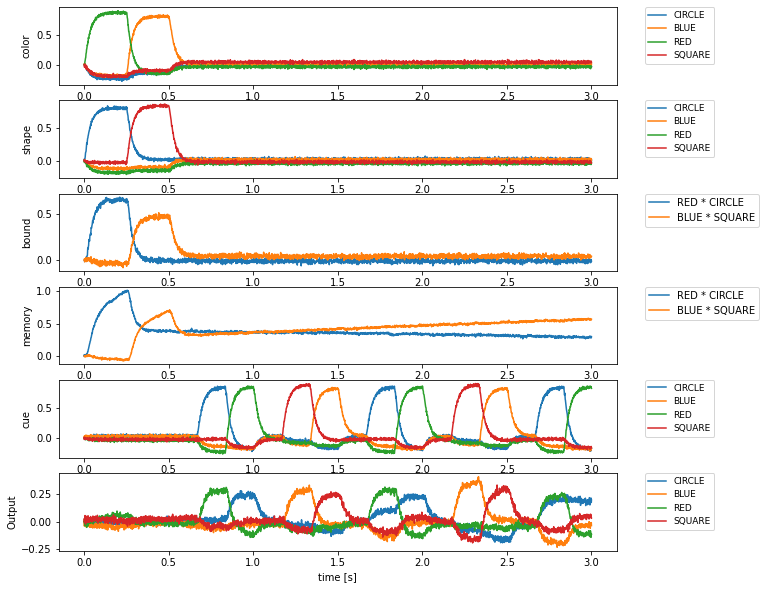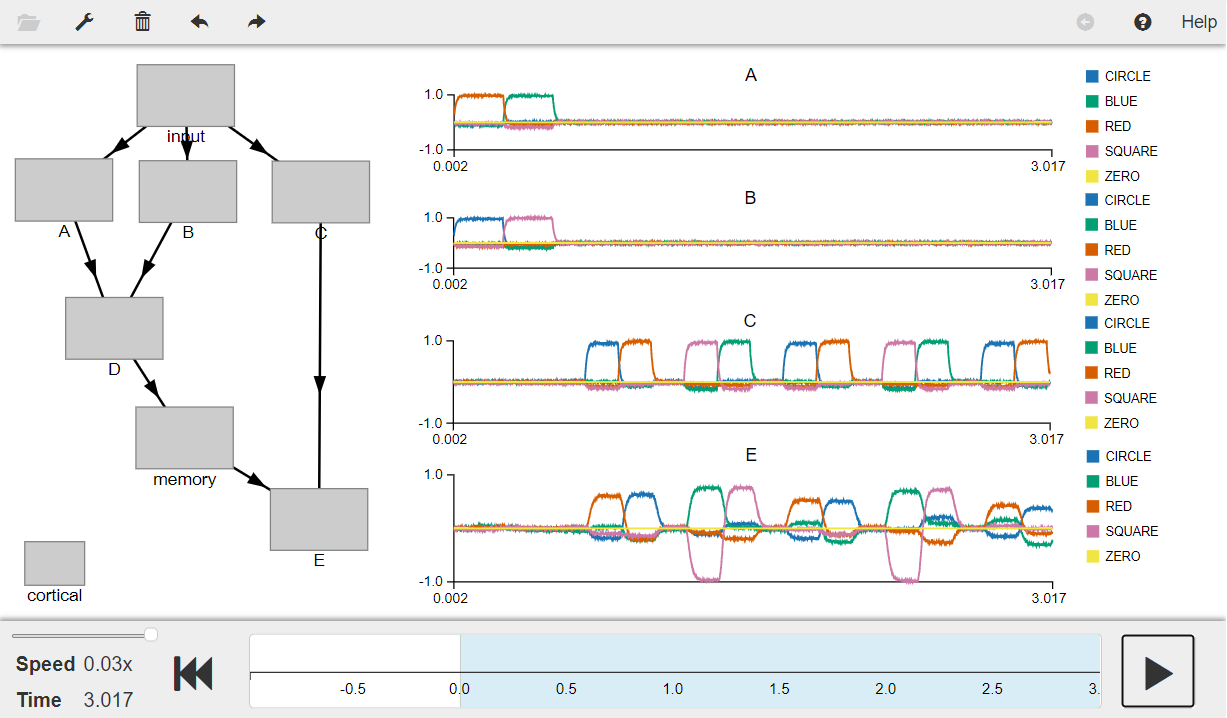- NengoLoihi
- How to Build a Brain
- Tutorials
- A Single Neuron Model
- Representing a scalar
- Representing a Vector
- Addition
- Arbitrary Linear Transformation
- Nonlinear Transformations
- Structured Representations
- Question Answering
- Question Answering with Control
- Question Answering with Memory
- Learning a communication channel
- Sequencing
- Routed Sequencing
- Routed Sequencing with Cleanup Memory
- Routed Sequencing with Cleanup all Memory
- 2D Decision Integrator
- Requirements
- License
- Tutorials
- NengoCore
- Ablating neurons
- Deep learning
Question Answering with Memory¶
This model shows a form of question answering with memory. You will bind two features (color and shape) by circular convolution and store them in a memory population. Then you will provide a cue to the model at a later time to determine either one of the features by deconvolution. This model exhibits better cognitive ability since the answers to the questions are provided at a later time and not at the same time as the questions themselves.
Note: Simplified method of building the model using the SPA (semantic pointer architecture) package in Nengo 2.0 is shown in the last few sections of this notebook.
[1]:
# Setup the environment
import matplotlib.pyplot as plt
import numpy as np
%matplotlib inline
import nengo
from nengo.spa import Vocabulary
Create the model¶
This model has parameters as described in the book, with memory population having 1000 neurons over 20 dimensions. The memory population is capable of storing a vector over time and it uses an integrator network to do so as discussed in the book.
The color input presented to the model is RED and then BLUE for 0.25 seconds each before being turned off. In the same way the shape input is CIRCLE and then SQUARE for 0.25 seconds each. Thus, when you run the model, it will start by binding RED and CIRCLE for 0.25 seconds and then binding BLUE and SQUARE for 0.25 seconds. The cue for deconvolving bound semantic pointers will be turned off for 0.5 seconds and then starts cycling through CIRCLE, RED, SQUARE, and BLUE within each second. The model will be able to determine the correct answer using the cue, even when the color and shape inputs have been turned off.
[2]:
dim = 32 # Number of dimensions
n_neurons = 300 # Number of neurons in population
n_conv = 70 # Number of neurons per dimension in bind/unbind populations
n_mem = 50 # Number of neurons per dimension in memory population
# Creating the vocabulary
rng = np.random.RandomState(0)
vocab = Vocabulary(dimensions=dim, rng=rng, max_similarity=0.1)
model = nengo.Network(label="Question Answering with Memory", seed=12)
with model:
# Ensembles
ens_A = nengo.Ensemble(n_neurons=n_neurons, dimensions=dim, label="A")
ens_B = nengo.Ensemble(n_neurons=n_neurons, dimensions=dim, label="B")
ens_C = nengo.Ensemble(n_neurons=n_neurons, dimensions=dim, label="C")
ens_D = nengo.Ensemble(n_neurons=n_neurons, dimensions=dim, label="D")
ens_E = nengo.Ensemble(n_neurons=n_neurons, dimensions=dim, label="E")
# Creating memory population and connecting ensemble D to it
tau = 0.4
memory = nengo.networks.EnsembleArray(
n_neurons=n_mem,
n_ensembles=dim,
label="Memory",
)
nengo.Connection(memory.output, memory.input, synapse=tau)
nengo.Connection(ens_D, memory.input)
# Creating the Bind network
net_bind = nengo.networks.CircularConvolution(n_neurons=n_conv, dimensions=dim)
nengo.Connection(ens_A, net_bind.A)
nengo.Connection(ens_B, net_bind.B)
nengo.Connection(net_bind.output, ens_D)
# Creating the Unbind network
net_unbind = nengo.networks.CircularConvolution(
n_neurons=n_conv, dimensions=dim, invert_a=True
)
nengo.Connection(ens_C, net_unbind.A)
nengo.Connection(memory.output, net_unbind.B)
nengo.Connection(net_unbind.output, ens_E)
# Getting semantic pointer values
CIRCLE = vocab.parse("CIRCLE").v
BLUE = vocab.parse("BLUE").v
RED = vocab.parse("RED").v
SQUARE = vocab.parse("SQUARE").v
ZERO = [0] * dim
# Function for providing color input
def color_input(t):
if t < 0.25:
return RED
elif t < 0.5:
return BLUE
return ZERO
# Function for providing shape input
def shape_input(t):
if t < 0.25:
return CIRCLE
elif t < 0.5:
return SQUARE
return ZERO
# Function for providing the cue
def cue_input(t):
if t < 0.5:
return ZERO
sequence = [ZERO, CIRCLE, RED, ZERO, SQUARE, BLUE]
idx = int(((t - 0.5) // (1.0 / len(sequence))) % len(sequence))
return sequence[idx]
# Defining inputs
input_A = nengo.Node(output=color_input, size_out=dim, label="Input A")
input_B = nengo.Node(output=shape_input, size_out=dim, label="Input B")
input_C = nengo.Node(output=cue_input, size_out=dim, label="Input C")
# Connecting input to ensembles
nengo.Connection(input_A, ens_A)
nengo.Connection(input_B, ens_B)
nengo.Connection(input_C, ens_C)
Add Probes to Collect Data¶
[3]:
with model:
A_probe = nengo.Probe(ens_A, synapse=0.03)
B_probe = nengo.Probe(ens_B, synapse=0.03)
C_probe = nengo.Probe(ens_C, synapse=0.03)
D_probe = nengo.Probe(ens_D, synapse=0.03)
E_probe = nengo.Probe(ens_E, synapse=0.03)
memory_probe = nengo.Probe(memory.output, synapse=0.03)
Run the model¶
[4]:
with nengo.Simulator(model) as sim: # Create the simulator
sim.run(3.0) # Run it for 3 seconds
Plot the results¶
[5]:
plt.figure(figsize=(10, 10))
plt.subplot(6, 1, 1)
plt.plot(sim.trange(), nengo.spa.similarity(sim.data[A_probe], vocab))
plt.legend(vocab.keys, bbox_to_anchor=(1.05, 1), loc=2, borderaxespad=0.0, fontsize=9)
plt.ylabel("color")
plt.subplot(6, 1, 2)
plt.plot(sim.trange(), nengo.spa.similarity(sim.data[B_probe], vocab))
plt.legend(vocab.keys, bbox_to_anchor=(1.05, 1), loc=2, borderaxespad=0.0, fontsize=9)
plt.ylabel("shape")
plt.subplot(6, 1, 3)
for pointer in ["RED * CIRCLE", "BLUE * SQUARE"]:
plt.plot(sim.trange(), vocab.parse(pointer).dot(sim.data[D_probe].T), label=pointer)
plt.legend(bbox_to_anchor=(1.05, 1), loc=2, borderaxespad=0.0, fontsize=10)
plt.ylabel("bound")
plt.subplot(6, 1, 4)
for pointer in ["RED * CIRCLE", "BLUE * SQUARE"]:
plt.plot(
sim.trange(), vocab.parse(pointer).dot(sim.data[memory_probe].T), label=pointer
)
plt.legend(bbox_to_anchor=(1.05, 1), loc=2, borderaxespad=0.0, fontsize=10)
plt.ylabel("memory")
plt.subplot(6, 1, 5)
plt.plot(sim.trange(), nengo.spa.similarity(sim.data[C_probe], vocab))
plt.legend(vocab.keys, bbox_to_anchor=(1.05, 1), loc=2, borderaxespad=0.0, fontsize=9)
plt.ylabel("cue")
plt.subplot(6, 1, 6)
plt.plot(sim.trange(), nengo.spa.similarity(sim.data[E_probe], vocab))
plt.legend(vocab.keys, bbox_to_anchor=(1.05, 1), loc=2, borderaxespad=0.0, fontsize=9)
plt.ylabel("Output")
plt.xlabel("time [s]")
[5]:
Text(0.5, 0, 'time [s]')

The graphs of shape, color, bound and memory show that first RED * CIRCLE and then BLUE * SQUARE are convolved (bound) and loaded into the memory population, so after 0.5 seconds the memory represents the superposition **RED * CIRCLE + BLUE * SQUARE**.
The last plot shows that the output is most similar to the semantic pointer bound to the current cue. For example, when the cue is CIRCLE, the output is most similar to RED.
Create the model using the nengo.spa package¶
[6]:
from nengo import spa
dim = 32 # The dimensionality of the vectors
rng = np.random.RandomState(4)
vocab = Vocabulary(dimensions=dim, rng=rng, max_similarity=0.1)
# Adding semantic pointers to the vocabulary
CIRCLE = vocab.parse("CIRCLE")
BLUE = vocab.parse("BLUE")
RED = vocab.parse("RED")
SQUARE = vocab.parse("SQUARE")
ZERO = vocab.add("ZERO", [0] * dim)
# Create the spa.SPA network to which we can add SPA objects
model = spa.SPA(label="Question Answering with Memory", vocabs=[vocab])
with model:
model.A = spa.State(dim)
model.B = spa.State(dim)
model.C = spa.State(dim)
model.D = spa.State(dim)
model.E = spa.State(dim)
model.memory = spa.State(dim, feedback=1)
actions = spa.Actions("D = A * B", "memory = D", "E = memory * ~C")
model.cortical = spa.Cortical(actions)
# Function for providing color input
def color_input(t):
if t < 0.25:
return "RED"
elif t < 0.5:
return "BLUE"
return "ZERO"
# Function for providing shape input
def shape_input(t):
if t < 0.25:
return "CIRCLE"
elif t < 0.5:
return "SQUARE"
return "ZERO"
# Function for providing the cue
def cue_input(t):
if t < 0.5:
return "ZERO"
sequence = ["ZERO", "CIRCLE", "RED", "ZERO", "SQUARE", "BLUE"]
idx = int(((t - 0.5) // (1.0 / len(sequence))) % len(sequence))
return sequence[idx]
# Inputs
model.input = spa.Input(A=color_input, B=shape_input, C=cue_input)
Run the model in nengo_gui¶
[ ]:
from nengo_gui.ipython import IPythonViz
IPythonViz(model, "ch5-question-memory.py.cfg")
Press the play button in the visualizer to run the simulation. You should see the “semantic pointer cloud” graphs as shown in the figure below.
Graphs A, B, C show the colour, shape and cue inputs respectively. Graph E shows that the output is most similar to the semantic pointer which was initially bound to the given cue (showin in C). For example, when SQUARE is provided as a cue, the output is most similar to BLUE.
[7]:
from IPython.display import Image
Image(filename="ch5-question-memory.png")
[7]:
